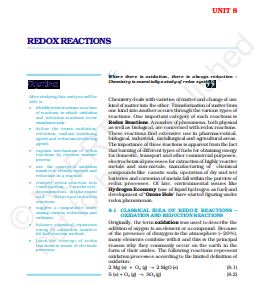‘NCERT Solutions for Class 11 Chemistry Chapter 8‘ PDF Quick download link is given at the bottom of this article. You can see the PDF demo, size of the PDF, page numbers, and direct download Free PDF of ‘Ncert Class 11 Chemistry Chapter 8 Exercise Solution’ using the download button.
NCERT Class 11 Chemistry Textbook Chapter 8 With Answer PDF Free Download

Chapter 8: Redox Reactions
Chemistry deals with varieties of matter and changes one kind of matter into the other.
The transformation of matter from one kind into another occurs through various types of reactions. One important category of such reactions is Redox Reactions.
A number of phenomena, both physical as well as biological, are concerned with redox reactions.
These reactions find extensive use in pharmaceuticals, biological, industrial, metallurgical, and agricultural areas.
The importance of these reactions is apparent from the fact that the burning of different types of fuels for obtaining energy for domestic, transport, and other commercial purposes, electrochemical processes for the extraction of highly reactive metals and non-metals, and manufacturing of chemical compounds like caustic soda, operation of dry and wet batteries and corrosion of metals fall within the purview of redox processes.
Of late, environmental issues like Hydrogen Economy (use of liquid hydrogen as fuel) and the development of ‘Ozone Hole’ have started figuring under the redox phenomenon.
8.1 Classical Idea of Redox Reactions – Oxidation And Reduction Reactions
Originally, the term oxidation was used to describe the addition of oxygen to an element or a compound.
Because of the presence of dioxygen in the atmosphere (~20%), many elements combine with it and this is the principal reason why they commonly occur on the earth in the form of their oxides.
The following reactions represent oxidation processes according to the limited definition of oxidation:
2 Mg (s) + O2 (g) Æ 2 MgO (s)
S (s) + O2 (g) Æ SO2 (g)
8.2.1 Competitive Electron Transfer Reactions
Place a strip of metallic zinc in an aqueous solution of copper nitrate as shown in Fig. 8.1, for about one hour. You may notice that the strip becomes coated with reddish metallic copper and the blue color of the solution disappears.
The formation of Zn2+ ions among the products can easily be judged when the blue color of the solution due to Cu2+ has disappeared.
If hydrogen sulfide gas is passed through the colorless solution containing Zn2+ ions, the appearance of white zinc sulfide, ZnS can be seen in making the solution alkaline with ammonia.
The oxidation number/state of a metal in a compound is sometimes presented according to the notation given by German chemist, Alfred Stock.
It is popularly known as Stock notation. According to this, the oxidation number is expressed by putting a Roman numeral representing the oxidation number in parenthesis after the symbol of the metal in the molecular formula.
Thus aurous chloride and auric chloride are written as Au(I)Cl and Au(III)Cl3. Similarly, stannous chloride and stannic chloride are written as Sn(II)Cl2 and Sn(IV)Cl4.
This change in oxidation number implies a change in oxidation state, which in turn helps to identify whether the species is present in an oxidised form or reduced form.
| Author | NCERT |
| Language | English |
| No. of Pages | 21 |
| PDF Size | 538 KB |
| Category | Chemistry |
| Source/Credits | ncert.nic.in |
NCERT Solutions Class 11 Chemistry Chapter 8 Redox Reactions
1. Write formulas for the following compounds:
(a) Mercury (II) chloride (b) Nickel (II) sulphate
(c) Tin (IV) oxide (d) Thallium (I) sulphate
(e) Iron (III) sulphate (f) Chromium (III) oxide
Answer:
(a) Mercury (II) chlorideHgCl_{ 2 }HgCl2
(b) Nickel (II) sulphateNiSO_{ 4 }NiSO4
(c) Tin (IV) oxideSnO_{ 2 }SnO2
(d) Thallium (I) sulphateTl_{ 2 }SO_{ 4 }Tl2SO4
(e) Iron (III) sulphateFe_{ 2 }(SO_{ 4 })_{ 3 }Fe2(SO4)3
(f) Chromium (III) oxideCr_{ 2 }O_{ 3 }Cr2O3
2. While sulphur dioxide and hydrogen peroxide can act as oxidising as well as reducing agents in their reactions, ozone and nitric acid act only as oxidants. Why?
Answer:
In sulphur dioxide (SO_{ 2 }SO2) the oxidation no. of S is +4 and the range of oxidation no. of sulphur is from +6 to -2.
Hence, SO_{ 2 }SO2 can act as a reducing and oxidising agent.
In hydrogen peroxide (H_{ 2 }O_{ 2 }H2O2) the oxidation no. of O is -1 and the range of the oxidation no. of oxygen is from 0 to -2. Oxygen can sometimes attain oxidation no. +1 and +2.
Therefore, H_{ 2 }O_{ 2 }H2O2 can act as a reducing and oxidising agent.
In ozone (O_{ 3 }O3) the oxidation no. of O is 0 and the range of the oxidation no. of oxygen is from 0 to –2. Hence, the oxidation no. of oxygen only decreases in this case.
Therefore, O_{ 3 }O3 acts only as an oxidant.
In nitric acid (HNO_{ 3 }HNO3) the oxidation no. of nitrogen is +5 and the range of the oxidation no. that nitrogen can have is from +5 to -3. Hence, the oxidation no. of nitrogen can only decrease in this case.
Therefore, HNO_{ 3 }HNO3 acts only as an oxidant.
Redox Reactions Textbook With Solutions PDF Free Download
